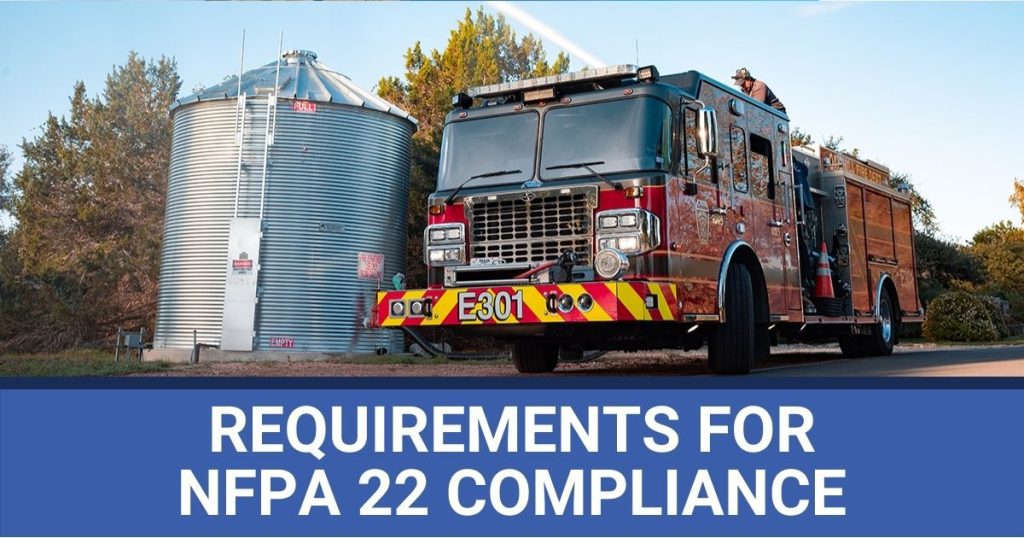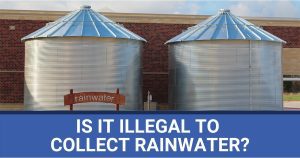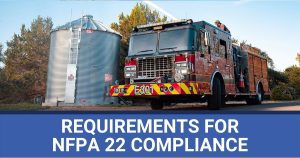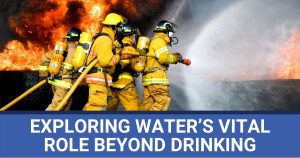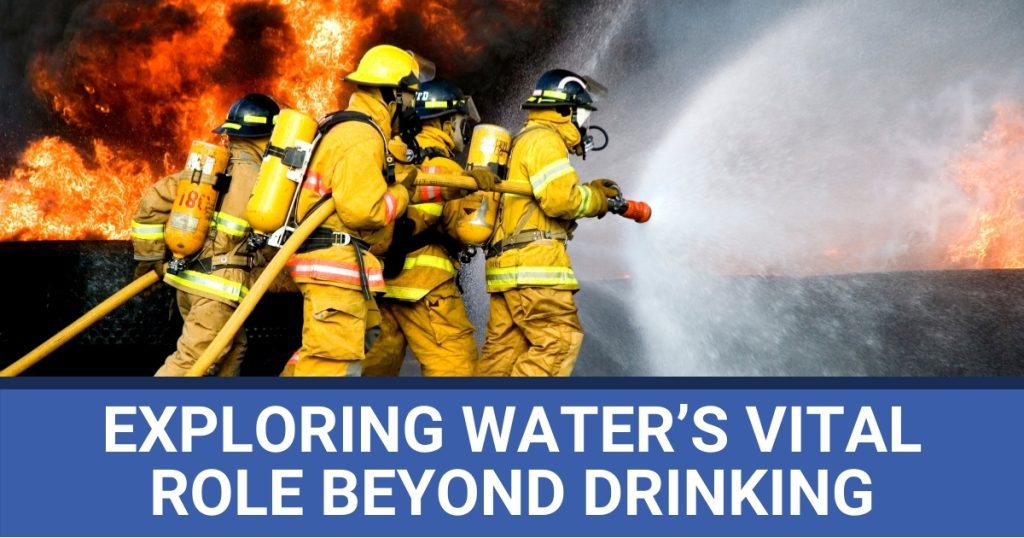Author: Josh Cizek, Marketing Specialist
Share this article
Fire protection is a critical component of building and life safety, and having reliable water storage fire protection tanks is essential for ensuring readiness in a fire emergency. The National Fire Protection Association (NFPA) has established NFPA 22 standards to guide the design, construction, installation, and maintenance of water storage tanks used for fire protection. Water Storage Tanks, Inc. is committed to delivering the highest quality products, strictly adhering to NFPA 22 standards. We offer corrugated bolted steel fire protection tanks that meet and exceed these rigorous requirements. This article aims to educate you on NFPA 22 compliance and equivalency, specifically for NFPA 22 equivalency for corrugated bolted steel fire tanks, and demonstrate why our fire tanks are considered the premium choice for fire protection in our industry.
Please refer to the References section for information about the editions of the standards and codes referenced in this article.
The Significance of NFPA 22
NFPA 22 is the industry standard that defines the requirements for the design, construction, installation, and maintenance of water storage tanks used for fire protection. The primary objective of this standard is to ensure that these fire tanks are structurally sound and equipped with the necessary fire protection appurtenances. Section 1.4 allows for an equivalency process for products not explicitly covered by the standard, and Section 1.7 allows for new technologies.
By definition, an NFPA 22 “Compliant” water tank is one that is explicitly detailed with its own dedicated chapter in the standard. All other tanks must be listed as NFPA 22 “Equivalent.”
Understanding NFPA 22 Compliant Fire Tanks
What is NFPA 22 Equivalency?
Section 1.4 of NFPA 22 states that technical documentation shall be submitted to the Authority Having Jurisdiction (AHJ) to demonstrate equivalency. This process involves proving that the proposed fire tank design meets or exceeds the performance requirements outlined in NFPA 22. In the case of corrugated bolted steel fire tanks, this means providing detailed documentation and calculations to confirm structural integrity and fire protection design.
As it pertains explicitly to corrugated bolted steel fire tanks, the concept of equivalency has been a topic of significant discussion within the NFPA 22 Technical Committee. To date, there has not been a summarized guideline that defines the metrics a corrugated bolted steel fire tank must meet to be equivalent in quality, strength, and effectiveness. Because of this, fire protection tank manufacturers and installers struggle to provide the necessary documentation to prove equivalency. Meanwhile, local governmental and non-governmental entities responsible for enforcing building and fire codes, or AHJs, such as Fire Marshals and engineers, find it challenging to determine what constitutes NFPA 22 equivalency and may overlook critical design elements.
Critical Components of NFPA 22 Equivalency
To demonstrate NFPA 22 equivalency, a fire protection tank manufacturer must provide critical pieces of information, including:
1. Proof of Structural Compliance
- A structural or civil engineer must perform structural calculations and consider live, dead, wind, snow, and seismic loads outlined in NFPA 22 Chapter 4.12. These loads must be further validated in accordance with ASCE 7: Minimum Design Loads and Associated Criteria for Buildings and Other Structures, with the more stringent loads taking precedence in the tank design.
- To withstand extreme weather conditions, the fire tank must be engineered to Risk Category IV under the International Building Code (IBC) Chapter 1604.5.
- Structural reviews ensure the fire tank’s safety during installation, inspection, testing, maintenance, and operation, even during natural emergencies. These are to be included in the submission package.
2. Proof of Compliance with Fire Protection Appurtenances
- The fire tank must accommodate the appurtenances defined in NFPA 22 and meet usable water volume requirements.
- The calculation of usable gallons, in accordance with NFPA 13, NFPA 1142, or fire code, along with the types of appurtenances used, falls within the design responsibility of a fire protection engineer or a professional specializing in fire protection design and is included in the submission package.
NFPA 22 Fire Tank Structural Requirements
Load Requirements for NFPA 22 Fire Tanks
To recap, the fire protection tank must conform to NFPA 22 and ASCE 7 standards for calculating snow, wind, and seismic loads. For reference, AWWA D103 provides formulas for allowable hoop shell tension. The fire tank must also be engineered to Risk Category IV under IBC Chapter 1604.5 to maintain water pressure for fire suppression.
Beware of other fire tank suppliers falsely claiming to sell NFPA 22 compliant fire tanks. Upon review of their load calculations, their fire tanks are often engineered only to meet Risk Category II. The AHJ must verify that the fire tank is engineered to Risk Category IV to withstand increased loads and prevent failure during extreme climatic events, reducing hazard risk to the community.
Roof Design Requirements for Fire Protection Tanks
According to NFPA 22 Chapter 4.12.2.4, roofs with slopes less than 30 degrees must support a uniform weight of 25 lb/ft² (122.06 kg/m2) on the horizontal projection, regardless of snow or ice loads. This requirement is essential for flat roof water tanks and ensures a safe, functional, and serviceable roof for personnel access. One might also find that other fire tank suppliers claim to sell NFPA 22 compliant fire tanks but fail to comply with this simple requirement. This is typically the case with suppliers who use a flat or dome roof for their fire tank. Therefore, the AHJ and engineer must confirm that the fire tank meets this requirement.
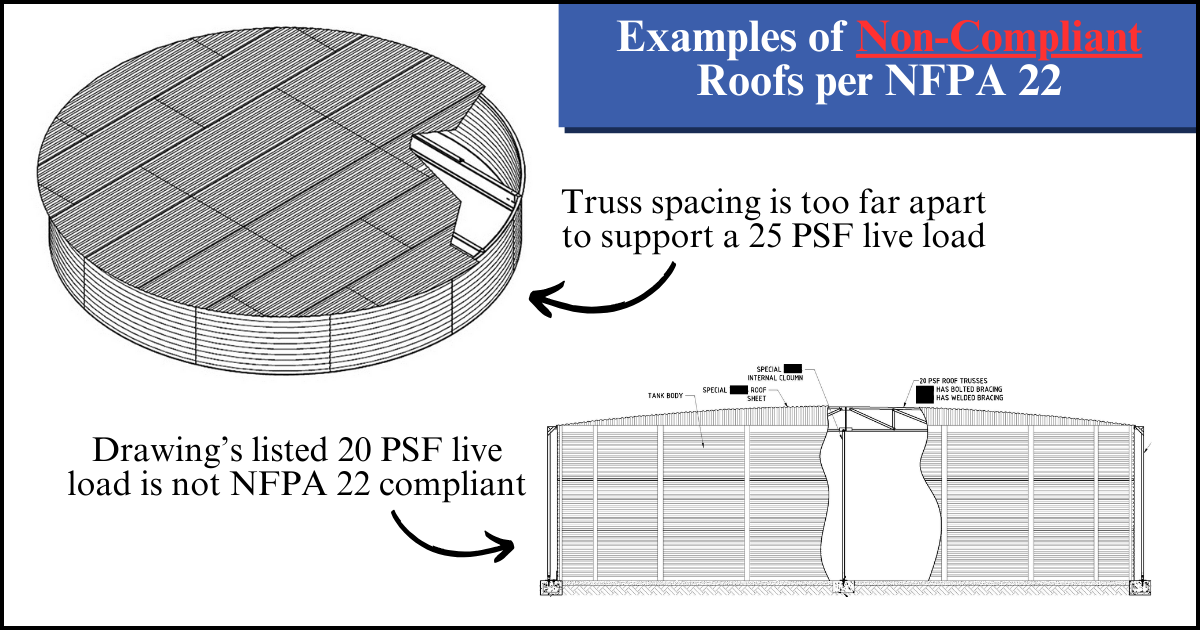
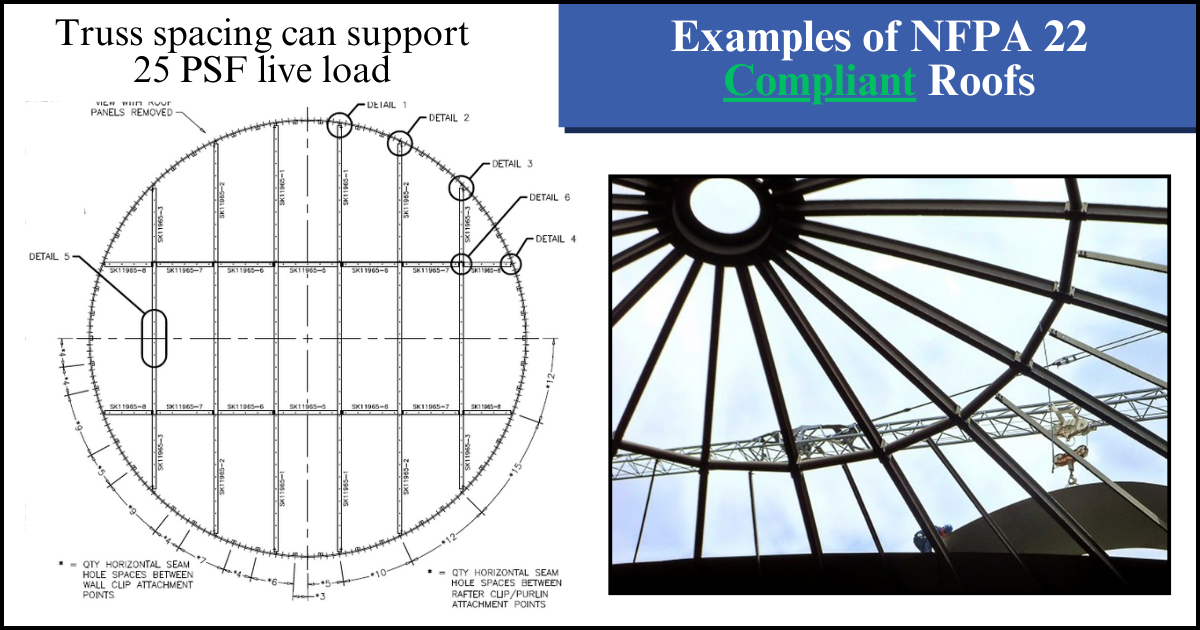
Geographical Considerations for Fire Protection Tanks
Different geographical areas produce varying wind, snow, and seismic load requirements. Adjusting structural designs based on site-specific climatic loads is crucial for fire tank design. Unfortunately, some fire tank suppliers use generic designs for all locations, increasing the risk of failure. The absence of the site address or coordinates on the engineering cover sheet often indicates improper design.
AHJs or engineers can use tools like the ASCE Hazard Tool website to verify the correct load requirements for a specific location. Considering regional factors, this resource uses ASCE 7 standards to determine the precise design loads needed for a given project address.
The following chart, based on the ASCE Hazard Tool, shows the Risk Category IV design loads for three different parts of the United States:
| City | Wind (Vmph) | Snow (lb/ft²) | Seismic (SDC) |
| New York, NY, USA | 130 | 62 | C |
| Houston, TX, USA | 145 | 11 | A |
| Portland, OR, USA | 107 | 69 | D |
Wind Load Requirements for Fire Protection Tanks
For high-wind areas, the roof and sidewall of the fire tank must be rigid and durable enough to withstand horizontal and updraft wind forces. Chapter 4.12.3.1 of NFPA 22 requires these loads to withstand a minimum of 30 lb/ft² (146.47 kg/m2) on vertical surfaces, 18 lb/ft² (87.88 kg/m2) on cylindrical surfaces, and 15 lb/ft² (73.24 kg/m2) on conical and double-curved surfaces. ASCE 7 calculates wind load factors such as wind directionality, topography, velocity pressure, gust effects, and internal and external pressure. According to Risk Category IV, this load’s importance factor is 1.15.
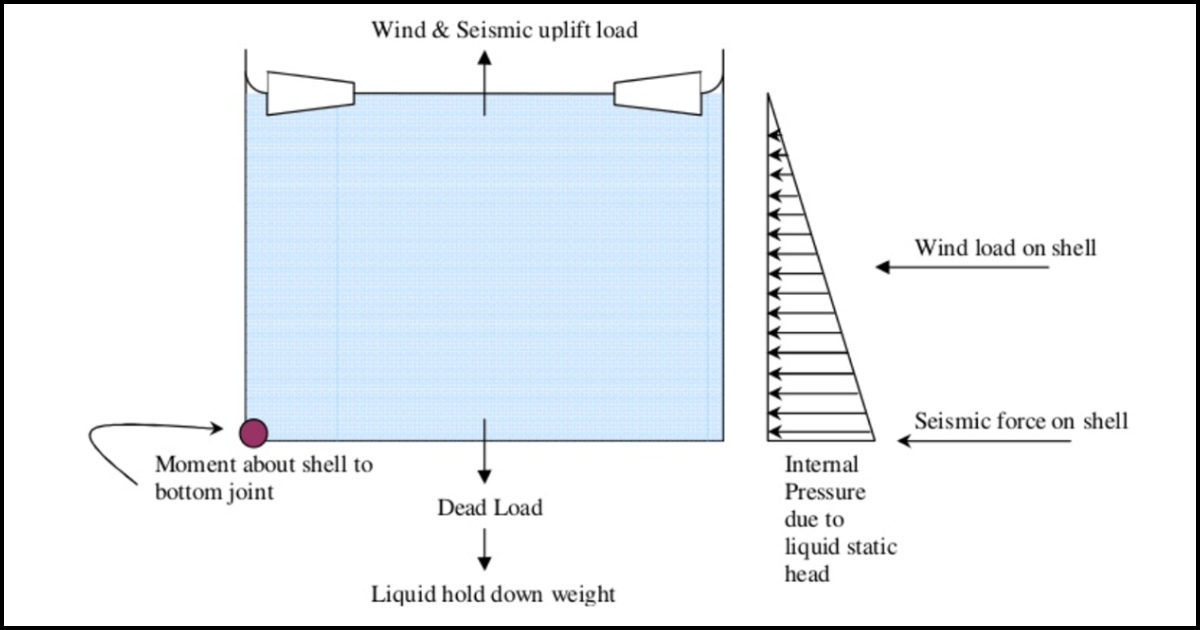
Seismic Load Requirements for Fire Protection Tanks
To prevent toppling or lifting, fire tanks must be securely affixed in high seismic areas. Guidelines in ACI 318 govern this factor. Tank sidewalls must withstand seismic compressive forces, possibly requiring vertical stiffeners. Seismic anchors or braces should be installed, with anchor rods stretching eight times their diameter. According to Risk Category IV, this load’s important factor is 1.50.
While NFPA 22 does not specify seismic loads, it mandates compliance with local building codes. Specific design criteria should be detailed in the relevant chapter or local codes, whichever is stricter, to ensure NFPA 22 compliance.
Concrete Foundations for Fire Protection Tanks
NFPA 22 Chapter 12.2 requires tank foundations to be set on a concrete slab, concrete ring wall with a sand cushion, compacted crushed stone, granular base, or self-anchoring system supported by granular berms. Additionally, NFPA 22 Chapter 12.6 mandates soil testing by a lab to ensure foundational support.
Given all these options, one might wonder what the best and most practical foundation for a fire tank is. In our professional opinion, a concrete-rebar slab foundation offers the highest structural integrity and safety, which is why we use this method for all our fire protection tanks. Some fire tank suppliers use a sand or gravel base, which is only permitted if the fire tank’s side walls are anchored to a concrete ring wall or if a steel floor is included for self-anchoring. However, using a sand or gravel base as a cushion or foundation introduces the risk of foundational shifts, compromising the fire tank’s structural integrity and potentially causing structural failure or punctures to the liner. This risk is particularly significant in areas with soft soil or prone to flooding. Therefore, it is recommended that a concrete-rebar slab be installed before tank installation in accordance with relevant codes.
Corrugated bolted steel fire protection tanks must comply with the equivalence and intent of the relevant sections to meet NFPA 22 standards.
Full Water Load Capacity for Fire Protection Tanks
The fire tank must be designed to withstand the live load of water when it is full. This includes both the weight of water (vertical projection) and the hoop stresses on the walls (horizontal projection). Freeboard calculations are necessary to demonstrate that the fire tank can withstand the sloshing effect of water. If these load capacities are not met, the fire tank may be at risk of failure, thereby setting the liner and tank up to burst out through the bottom.
Fire Protection Design on NFPA 22 Fire Tanks
NFPA 22 specifies the essential appurtenances for compliant fire protection tanks, and a licensed professional engineer or fire protection designer typically handles the design.
Submission requirements for corrugated bolted steel fire tanks are similar to other tank styles. To prove equivalency, the designer must show that the fire tank supports essential appurtenances and meets the required water capacity as dictated in NFPA 22 Chapter 4.1. This includes the net capacity between the inlet of the overflow and the discharge outlet, or for suction tanks, the level of the vortex plate.
What Must Be Included in a NFPA 22 Fire Protection Tank Submittal
NFPA 22 Chapter 4.6.2.2 details what must be included in a proper submittal:
- Size and arrangement of all pipes
- Size, location, and type of all valves, tank heater, and other accessories
- Steam pressures available at the heater
- Arrangement of, and full information regarding, the steam supply and return system together with pipe sizes
- Details of construction of the frostproof casing
- Where heating is required, heat loss calculations
- Structural drawings and calculations
- Seismic bracing details and calculations
- Operational settings and sequence of operation
- Monitoring equipment and connections
- Underground details, including foundations, compaction, and backfill details and calculations
- Buoyancy calculations for buried tanks (not relevant for above-ground corrugated bolted steel fire protection tanks)
The AHJ will then review the submittal to ensure compliance, as with any other fire tank style.
Essential NFPA 22 Fire Protection Tank Accessories
An NFPA 22 compliant fire tank will include the following fire protection accessories:
1. Anti-Vortex Fitting
- These prevent air from entering the pump suction line and must follow NFPA 22 Chapter 14.2.13.2 guidelines. They are attached to the discharge outlet pipe.
- The steel plate must be at least twice the diameter of the outlet pipe and at be least 6 inches (15.24 centimeters) above the floor.
- If mounted to the wall, the elbow must have a long radius.
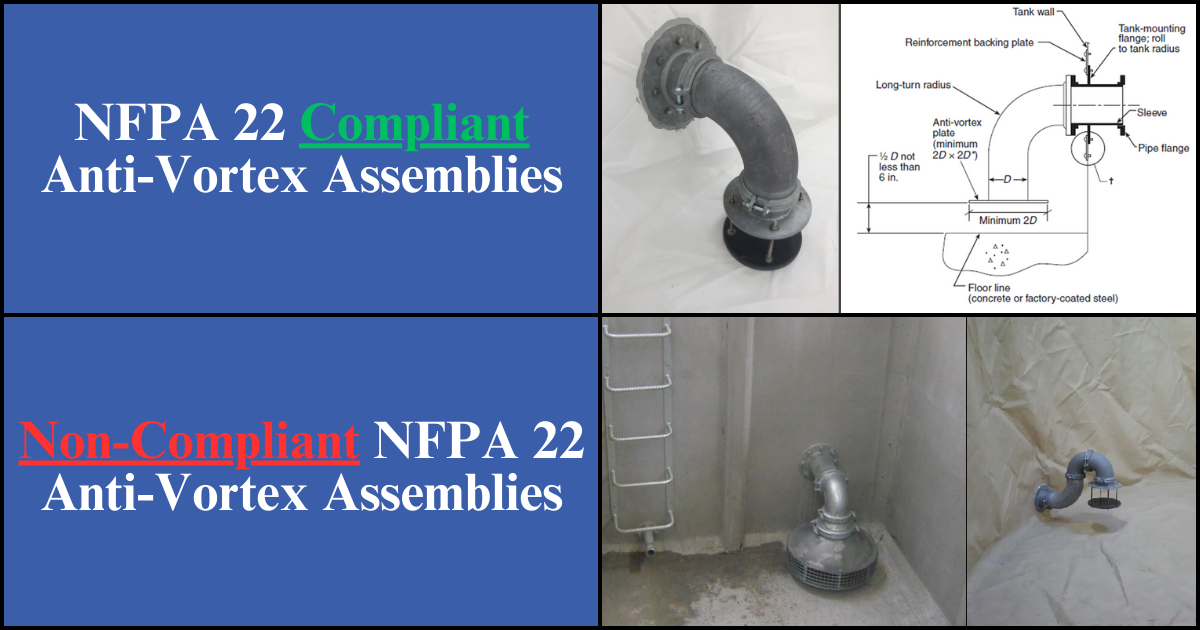
2. Roof Vents
- Prevents internal vacuum suction pressures that can damage the fire tank’s structure as per NFPA 22 Chapter 4.15.
- The vent must be located above the maximum water level and at least one-half the diameter of the discharge or fill pipe.
- A corrosion-resistant screen with 3/8-inch (0.95 centimeters) holes will be included.
- If only a screen is used for the vent, it must be 1.5 times the diameter of the discharge or fill pipe.
3. Water Level Gauges
- The water level gauge aims to accurately display the current water level.
- Some AHJs may require low level alarms installed in conjunction with or in lieu of a traditional water level gauge.
4. Heating Systems
- These keep water temperatures above freezing in cold climates following NFPA 22 Chapter 16.
- This may not be required depending on the geographic location of the fire tank. If the geography experiences freezing temperatures, a heating system must keep the water temperature at or above 42o Fahrenheit (5.6o Celsius).
- A low water temperature alarm set at 40o Fahrenheit (4.4o Celsius) is to be included.
5. Exterior Ladder with Fall Arrest (Optional)
- An exterior ladder allows one to safely climb the fire tank’s roof for maintenance or inspection.
- Per OSHA 1910.28 guidelines, a fixed ladder must have a fall arrest when the ladder is over 24 feet (7.32 meters) tall.
- Safety cages are no longer recognized as OSHA-compliant, but they may still be practical for lock-out or tamper prevention.
- The ladder must support a vertical load of 350 pounds (158.76 kilograms), as noted in NFPA 22 Chapter 4.12.6.1.
6. Access Hatch
- An access hatch must be affixed to the tank’s roof to allow personnel to enter the tank for maintenance and inspection.
- According to NFPA 22 Chapter 4.14.1.1, OSHA-compliant standard railing must be installed around the roof’s access hatch and other accessories that require tank access.
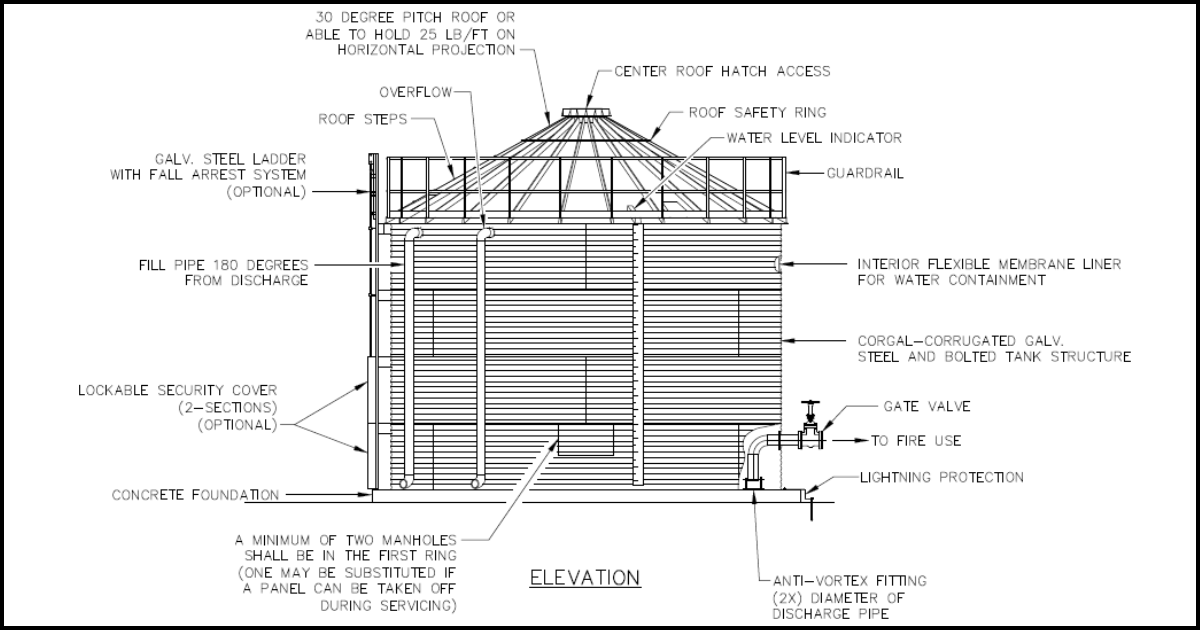
Flexible Membrane Liners in NFPA 22 Fire Tanks
While NFPA 22 plays a central role in ensuring the safety and reliability of fire protection tanks, the quality of flexible membrane liners paired with the fire tank system must also be considered.
Flexible membrane liners are practical for sealing water in fire protection tanks. They are easy to install and repair and extend the fire tank’s lifespan while being cost-effective. The liner must support the water’s pressure and weight without damage.
Currently, there are no specific standards for flexible membrane liners in steel, above-ground fire protection tanks, but three resources can provide some guidance:
- AWWA D102: A steel water storage tank used for potable water storage and utilizing a liner must have a minimum dry film thickness of 25 mils (depending on the coating system employed).
- AWWA D130: A flexible membrane liner utilized in a water reservoir must have a minimum thickness of 30 mils.
- FM 4020: Fire protection tanks utilizing unreinforced liners should be at least 30 mils thick, whereas scrim-reinforced liners should be at least 24 mils thick.
With varying numbers, it can be challenging to determine what is considered an NFPA 22 equivalent liner for corrugated bolted steel fire tanks. However, it is crucial to understand that water reservoirs are subject to environmental hazards that are not present in enclosed water storage tanks. Hence, AWWA D130’s requirement of a thickness of 30 mils is arguably excessive for a fire protection tank since the liner will be utilized in a closed space sheltered from the environment.
It is important to remember that FM Approvals is a sub-entity of FM Global, a for-profit mutual insurance company that sets its own standards for fire tanks separate from NFPA 22. This company requires tank manufacturers to pay for approval of a fire tank design and installation. Because of this, a fire tank can meet or exceed FM 4020 fire tank standards without being considered “FM Approved.” This contrasts with non-profit organizations like NFPA and AWWA, which establish international standards that are publicly reviewed, assessed, and adopted by governing laws and codes. For this reason, FM Approvals’ liner thickness requirements are subject to debate and professional opinion.
It can be argued that AWWA D102’s liner thickness requirement of 25 mils is equivalent to NFPA 22. While the two standards discuss water storage tanks with differing applications (potable water storage versus fire protection water storage), the purpose of the liner storing water remains the same.
Therefore, we suggest a minimum reinforced flexible membrane liner thickness of 25 mils for NFPA 22 equivalency in corrugated bolted steel fire tanks. We also recommend installing a geotextile pre-liner for additional cushioning protection. This pre-liner prevents potential tears in the liner caused by friction or wear from the steel walls and bolts. It additionally allows condensation to wick between the liner and steel walls and, through gravity, exits the tank, thereby mitigating corrosion.
In our professional opinion, the fire protection designer and the AHJ are responsible for determining NFPA 22 equivalence for liners, as the liner system is not essential to structural load calculations. These opinions are based on extensive experience in manufacturing and 20+ years installing fire protection tanks. Water Storage Tanks, Inc. was the first company to introduce this style of fire tank to the United States. As the corrugated bolted steel water storage tank industry’s pioneer, we have effectively demonstrated that our fire tanks comply with all structural and fire protection standards and codes where relevant. Our fire tanks have proven to stand against the test of time and face environmental adversity through decades of use.
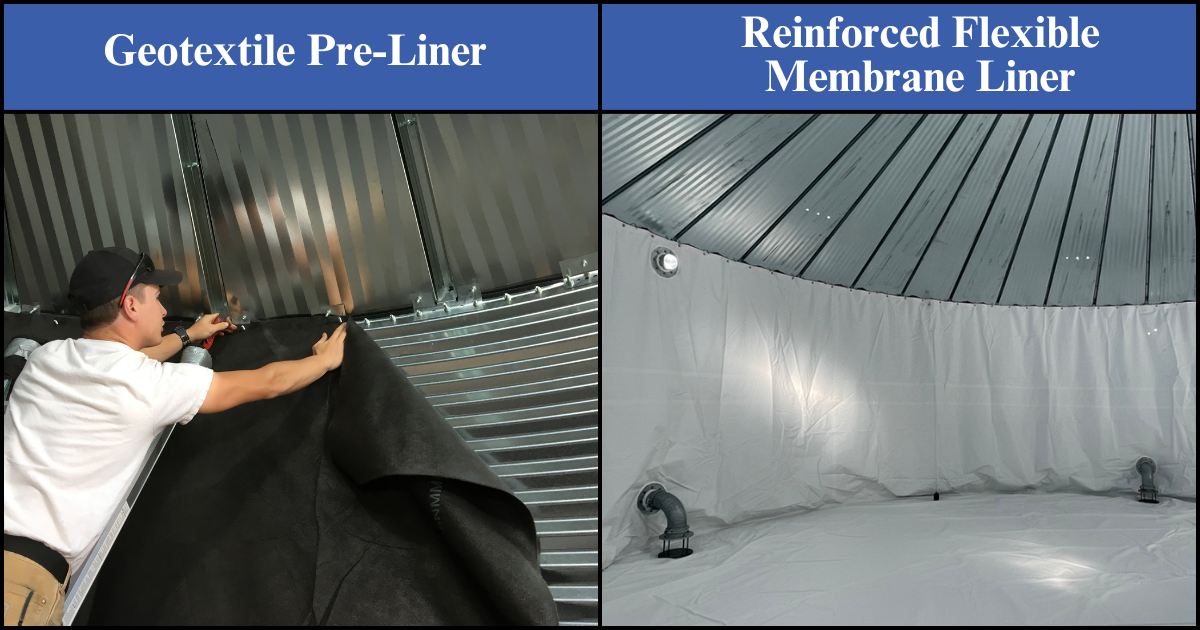
Submitting Your NFPA 22 Fire Tank Designs
To demonstrate NFPA 22 equivalency, a comprehensive submission package for the fire tank must be prepared, including:
1. Structural Design Calculation Document
- Site-specific structural reviews that guarantee the fire tank’s safety during installation, inspection, testing, maintenance, and operation, including during natural emergencies.
- Detailed structural calculations demonstrating the fire tank’s ability to withstand various loads, including site-specific design considerations such as wind, snow, seismic loads, foundational engineering, and soil test reports.
- Structural engineering follows NFPA 22, ASCE 7, IBC, AWWA D103, and local structural and building codes.
- Prepared and stamped by a licensed structural or civil engineer. The engineer’s stamp must show he/she is licensed in the state the project is being developed within.
2. Fire Protection Design Document
- Detailed drawings and specifications on all fire protection components’ size, type, arrangement, and orientation.
- Appurtenances must be specified by a fire protection engineer or a professional specializing in fire protection design and included in the submission package.
- The fire tank meets usable water volume requirements as defined by NFPA standards (such as NFPA 13 or 1142) or in compliance with locally adopted fire codes.
- Prepared and stamped by a licensed fire protection engineer or professional specializing in fire protection tank design.
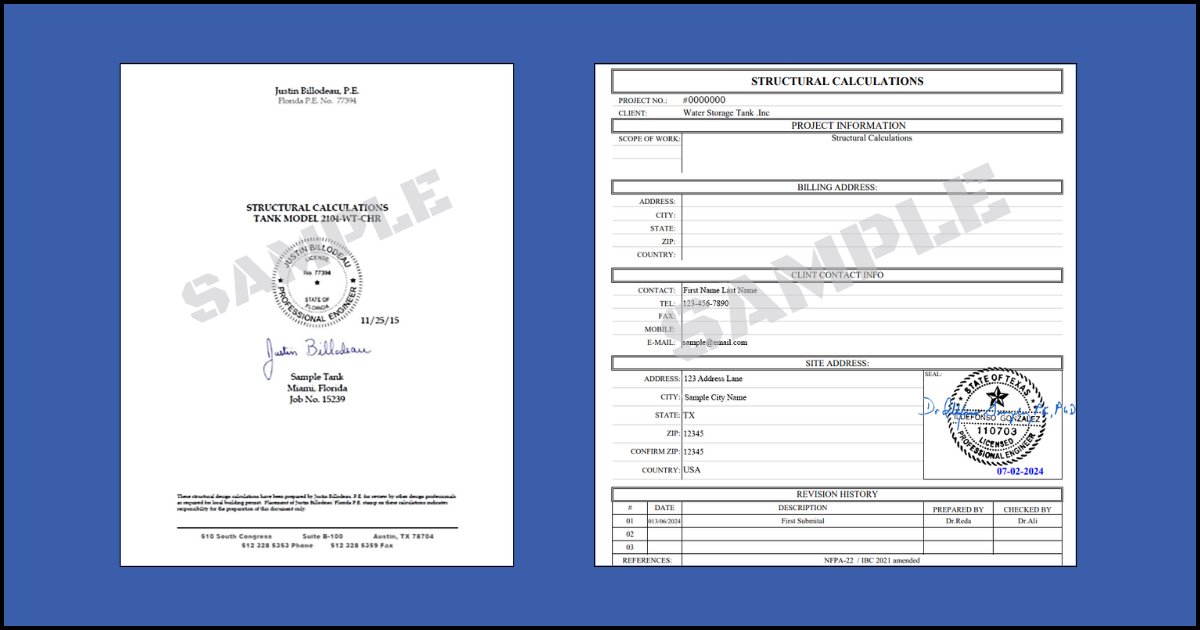
Alternatively, it may be possible for one document to be submitted to the AHJ with two engineer stamps. However, this depends on the AHJ’s preference. To do this, the structural or civil engineer stamps the full submittal document for the structural design while notating an “exclusion” for the fire protection design calculations and notes. Similarly, the fire protection engineer or professional specializing in fire protection tank design would review the full submittal document separately and notate an “exclusion” for the structural design calculations and notes.
The AHJ, often a Fire Marshal, reviews this comprehensive submittal package to ensure all standards and codes are met and the fire tank design is approved. Upon review, the AHJ can accept or reject the fire tank design. Should a water storage tank supplier follow all the steps and check off all the boxes described in this article, there should be no problem with receiving approval for the fire tank’s design. However, every AHJ is different, and they have the final say. Be sure to provide all necessary and supplemental documentation to prove that your corrugated bolted steel fire protection tank meets or exceeds NFPA 22 standards.
If anything is in question, consider consulting experienced, licensed professional engineers or AHJs to ensure adherence to safety standards. For additional guidance, consider contacting trusted manufacturers like Water Storage Tanks, Inc., which has consistently demonstrated adhering to high compliance standards.
Why Choose Water Storage Tanks, Inc.?
Proven Expertise
Water Storage Tanks, Inc. has been a pioneer in the corrugated bolted steel water storage tank industry for over two decades, bringing the first corrugated bolted steel fire protection tanks to the American and Canadian markets. During that time, we received countless AHJ approvals for our fire protection tank projects, which were engineered to meet the custom needs of our customers. To this day, these fire tanks have stood and operated efficiently and will continue to do so for many decades to come.
Kai Langendoen, President of Water Storage Tanks, Inc., sits on the NFPA 22 Technical Committee and AWWA Committee 306. He has been diligently working to establish specific standards for corrugated bolted steel water storage tanks, addressing the absence of these standards. Our extensive experience and commitment to NFPA 22 compliance make us the trusted choice for fire protection tanks and set us as a benchmark for the industry.
Premium Quality
While some manufacturers may opt for cost-cutting measures, we are committed to using only the highest quality materials and strictly adhering to NFPA 22 standards. Unlike suppliers who source steel from abroad and utilize pre-cut, pre-fabricated components stored in warehouses, we take a different approach. We proudly source 100% of our materials from the United States and uniquely form, cut, and build our fire protection tanks for each individual project. No one tank is the same because no project is the same, so you can proudly say you have something truly exceptional and one-of-a-kind.
We offer one of the most extended warranties in the industry, with a 30-year manufacturer’s warranty on the tank shell and a minimum of a 10-year manufacturer’s warranty on the liner. We are confident in the quality and installation of our fire tank, but should anything occur, you can rest easy knowing you are covered. Combined with fast installation times that take days rather than weeks, your fire protection tank project can be up and running on time and on budget.
Comprehensive Support
Our team of experts provides unparalleled support throughout the ideation, planning, engineering, approval, and installation process. Have a question about water storage tanks? Just ask! Our team has more experience and knowledge on corrugated bolted steel fire protection tanks than anyone else out there. We offer a wide range of accessories, liners, roof styles, and fittings to ensure your tank meets all necessary requirements. Additionally, we maintain a network of dealers and distributors throughout the United States and Canada. No matter where your project may be, we will send a team of certified professional installers who are guaranteed to get the job done.
Ready to make the jump? Request a quote on your next fire tank project from us, and a member of our experienced Sales team will contact you.
Interested in becoming a certified CorGal® dealer? Fill out the application form, and our General Manager will contact you to discuss the opportunity further. For companies looking to become a certified build team, please call or email us, and a team member will reach out to you to discuss the opportunity.
Conclusion
When there is no specific industry standard for corrugated bolted steel water tanks, the use of these water storage tanks for fire protection can be permitted by the AHJ when shown to be equivalent to the requirements of NFPA 22. This includes focusing on the tank’s structural integrity and ability to function as a fire protection storage vessel in emergencies. Simply adding NFPA 22 specified appurtenances does not provide equivalency. The fire tank’s design must be thoroughly reviewed and approved by an AHJ and potentially a licensed fire protection engineer.
Confirming a water tank’s equivalency is a multi-tiered process. Experienced engineers and designers must provide detailed calculations and compliance evidence with submittal packages. Due to the unique disciplines of structural engineering versus fire protection design, it is likely that two PE stamps be provided before the AHJ’s review and approval: one for structural design calculations and another for fire tank design. These two documents can then be combined for submittal. Alternatively, it may be possible for one engineer to stamp the full submittal for the fire tank design while “excluding” structural calculations, which another engineer would then review separately and similarly “exclude” the fire tank design.
Ensuring your fire protection water tanks comply with NFPA 22 standards is essential for safeguarding lives and property. By focusing on structural compliance, fire protection design, and water containment, you can ensure your fire protection tanks are reliable and ready to perform during a fire emergency. At Water Storage Tanks, Inc., we are committed to providing the highest quality fire tanks that meet and exceed NFPA 22 standards, making us the premium choice for fire protection solutions.
For more information, visit our website or contact us today to learn how we can assist with your fire protection needs.
References
American Concrete Institute. (2022). ACI 318-19(22): Building Code Requirements for Structural Concrete and Commentary (Reapproved 2022).
American Society of Civil Engineers. (2021). ASCE/SEI 7-22 Minimum Design Loads and Associated Criteria for Buildings and Other Structures.
American Water Works Association. (2021). AWWA D102-21 Coating Steel Water-Storage Tanks.
American Water Works Association. (2019). AWWA D103-19 Factory-Coated Bolted Carbon Steel Tanks for Water Storage.
American Water Works Association. (2019). AWWA D130-11 Geomembrane Materials for Potable Water Applications.
ASCE. (2024). ASCE Hazard Tool. ASCE Hazard Tool. https://ascehazardtool.org/.
FM Approvals. (2011). Approval Standard for Steel Tanks for Fire Protection.
International Code Council. (2020). 2021 International Building Code (IBC).
National Fire Protection Association. (2022). NFPA 13 Standard for the Installation of Sprinkler Systems.
National Fire Protection Association. (2022). NFPA 22 Standard for Water Tanks for Private Fire Protection.
National Fire Protection Association. (2022). NFPA 1142 Standard on Water Supplies for Suburban and Rural Fire Fighting.
Occupational Safety and Health Administration. (2016). 1910.28 – Duty to have fall protection and falling object protection. Osha.gov. https://www.osha.gov/laws-regs/regulations/standardnumber/1910/1910.28.
Connect With Us on Social Media
Check Out Our Latest Posts
Explore Post Categories
- CorGal® Tanks (1)
- Fire Protection (2)
- Irrigation & Agriculture (1)
- News (1)
- NFPA 22 (2)
- Potable Water (2)
- Rainwater Harvesting (1)


